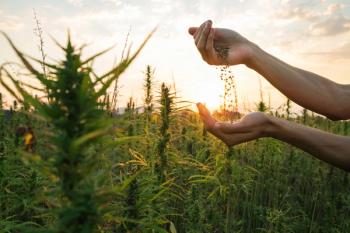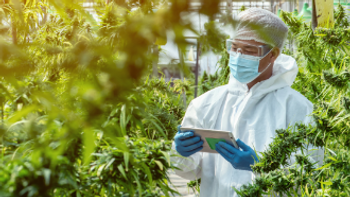
Clone Nutrient Treatment Studies During Root Propagation on Various Strains of Cannabis sativa
Here the authors present findings from their study involving six different nutrient treatments applied during the cloning cycle for approximately 500 plants. This paper focuses on the observed benefits in this study involving the use of an amino acid and salt solution using food-grade precursors.
This paper provides results from a study of the effects from different nutrient treatments used during the cloning process of a cannabis plant. Five different nutrient treatments were evaluated along with a control group. In the study, approximately 500 clones were grown from five different strains of cannabis “mother” plants. The study was done at Pecos Valley Production (PVP, a commercial cannabis cultivation and harvesting company in southern New Mexico). In a time-paired experiment six different nutrient treatment conditions were applied during the cloning process. Thirteen replica clones of each unique treatment condition and strain were processed to aid in achieving statistical significance. The experiment was co-designed by the principal investigators to evaluate which nutrient treatment method could potentially “first root” (first visible rooting outside of the clone media [rockwool or coco plug]) and “fully root” (sufficient visible roots to allow for successful transplant to the vegetative stage “Veg”) the fastest. The primary goal of the study was to allow for increased time during the plant “Veg” conditions to enable increased production biomass yield at PVP post-harvest and reduce overall cultivation production cycle times.
The six nutrient treatment conditions used involved individual and combinations of the company’s RMD chemistry, an algae-based treatment, an ozone water-based treatment, as well as the process of record (POR) production nutrient method involving commercial chemistries. Of the six treatments, the company’s RMD chemistry was the fastest to “first root” and had the highest overall dry weight per plant post-harvest. For all parameters studied, the POR control treatment did not come out first of the six treatments applied. It is important to note that the PVP facility has been using the control treatment for quite some time and the results from the studyshows that there is tremendous opportunity to improve PVP baseline production performance. The control treatment was factored into the design of a follow-on study involving ~4000 clones at PVP.
Introduction
The cannabis industry is growing at a rapid rate and due to increasing competition and patient demand, cannabis operators are under extreme pressures to decrease costs and increase production yield. One avenue to reduce costs and increase production yield per year is to reduce the individual cloning time which is typically the first step in a cannabis production process. These authors embarked on a study involving six different nutrient treatments applied during the cloning cycle for approximately 500 plants. This paper focuses on the observed benefits in this study involving the use of an amino acid and salt solution using food-grade precursors. The product chemistry featured in the present article is the product of electrolysis in an electrolytic cell. For more information about electrolytic technology see the cited literature (1). We have observed that these proprietary solutions can provide beneficial nutrients to roots and leaves and increased post-harvest biomass when applied as a foliar application to cannabis plants while having a side benefit of creating a difficult environment for pathogens to survive. For more information about the pathogen fighting properties of this electrolyzed amino acid and salt chemistry used in this study, please see the cited literature (1).
Experimental Procedure
Traditional cloning in open air disposable cups in a typical grow room under controlled environmental conditions of temperature and humidity was performed. All clones were cut from their “mother” plants at a 45-degree angle on the same day and then dipped in Clonex gel root enhancer. The clones were then inserted into root plugs (rock wool), placed into a plastic tray to hold the root plugs, and fed at the root level with Clonex nutrient solution. In addition, for this experiment clones were foliar fed (to the clone leaves) by spraying one of the six nutrient chemistries on Mondays and Thursdays by the production team at Pecos Valley Production (PVP). After one week, the team began inspecting by lifting the plastic plug tray to look for visible indication of “first visible roots” or when “fully rooted” conditions existed on all clones. When “first rooting” or being visibly “fully rooted” photos of all clones were taken.For examples of the “first root” and “fully rooted” conditions, please see Figure 1. After photos were taken, the root plugs were quickly re-inserted into the plastic root trays. The six nutrient treatments used were
- Terra Vera’s RMD product diluted 3:1 with reverse osmosis (RO) water,
- a commercial algae product,
- ozone treated water,
- a combination of 50% Terra Vera RMD and ozone water,
- a combination of algae and ozone water, and
- no added foliar spray to mimic the process of record (POR) “Control” Clonex root-fed only nutrient solution production process.
The five cannabis strains used in this study were Pinky’s Advice, Forbidden Fruit, Blue Tahoe, Kandy Kush, and Spiced Punch. When not stated, all other normal cannabis production process steps were followed at PVP in this study. Clone domes were opened on days of foliar spraying and rooting was inspected by lifting the clone trays and individual clones. All clones were barcode labeled for ease of tracking purposes during the harvesting step. Dead clones that did not survive the cloning or transplant process steps were culled from the study. At the end of the cloning process, all clones were transplanted into initially 1-gallon pots filled with the PVP POR soil mixture and all other cultivation steps followed involved PVP POR steps. Upon harvest, the plant’s individual dry weights were measured in grams and their barcode label numbers were recorded.
In a parallel study conducted at the R&D facility of Terra Vera in Albuquerque, New Mexico, clones were grown in similar clone domes and processed with either Terra Vera’s RMD 3:1 solution or just with Clonex solution, both foliar fed. In this study, the number of “visible roots” was counted from clones of three strains of cannabis which were “Unicorn Poop,” “Stool Sample,” and “Peanut Butter Punch Bowl.” The clones were foliar fed by spraying with a standard spray bottle on Mondays and Thursdays as well. This was conducted until all clones were “fully rooted” in the clone dome. The number of “visible roots” for these clones were compared to further validate the findings observed at PVP Roswell.
Cloning Results
As was stated previously, all strains of the clones were treated the same way and on the same days in the same grow room. After seven days of cloning, selected members of the cultivation’s cloning team inspected the six clone trays for “first rooted” and “fully rooted” conditions. The counts of all clones in each condition were entered into an electronic laboratory notebook to track progress of the experiment. On the same foliar spraying days (Mondays and Thursdays) the clone trays were inspected by lifting and tilting the clone trays, as is shown for the Terra Vera clone tray in Figure 2. In this case, the tray was inspected on Day 16 of cloning and a very high percentage of the clones exhibited the “fully rooted” condition per the assessment of the clone team’s “trained eyes.” One downside of this experiment was that all cloning timeframes were built around the facilities production schedule, which was aligned to the control’s cloning schedule in terms of when the clones were transplanted to Veg 1-gallon pots. In a follow-on study, which is currently underway at PVP, clones were transplanted to Veg when they were deemed ready by delaying some of the clone’s start times. Results from that study will be shared via publication at a later date.
On day 10 of cloning, before the third foliar spray was conducted, the trays were lifted to assess the number of “fully rooted” clones by treatment type. The team also determined which clones had to be culled from the experiment since they did not survive the cloning process. The percentage of “fully rooted” clones and the percentage that did not survive (and were culled out) are shown in Table I. As is indicated in this figure, the Terra Vera clones at that point of cloning had the highest percentage of “fully rooted” clones of the 500 clones inspected. In terms of mortality rate, the control treatment condition had the lowest mortality rate at 1% and the Terra Vera treatment had the second lowest mortality rate at 4%.
When the clones were all transferred to Veg pots, all clones were lifted from their clone trays and individual photos of each clone were taken and inserted into the electronic laboratory notebook synched by their treatment type and strain. Barcode numbers were assigned to each clone for subsequent tracking at the point of harvest. Some representative photos of “fully rooted” clones taken from the Terra Vera tray are shown in Figure 3. As you can see, some strains of clones exhibited very different clone root morphology in terms of the number and location of visible roots, however the cloning team did properly assess that all four of these clones were “fully rooted” and ready for transplant to Veg 1-gallon pots.
As was noted earlier, the parallel study was being conducted in Albuquerque to validate the observed findings in the PVP Roswell production facility.In this study, three strains of clones “Peanut Butter Crunch Bowl,” “Stool Sample,” and “Unicorn Poop” were cloned in traditional clone domes. The clones were treated and foliar fed with 3:1 RMD or Clonex “Control” solution. At each treatment day, after one week, the clones were inspected for “first rooting” and “fully rooted” conditions. The number of visible roots were also counted in this case to help quantify the relative speed of cloning of the different strains under different treatment conditions. As is shown in Figure 4, there was no noticeable difference in the number of visible roots counted on day 15 of the cloning cycle for the “Peanut Butter Crunch Bowl” strain. This strain, according to the clone source in Albuquerque, is a “fast and vigorous rooter.” However, this source also noted that the “Unicorn Poop” strain is a “slow rooter” and these statements were born out in the data shown in Figure 4. For “Stool Sample” and “Unicorn Poop” the Terra Vera 3:1 treatment exhibited a larger number of visible roots thereby indicating it waws a superior nutrient treatment process in its ability to grow roots faster which was in alignment with the PVP Roswell data as shown in Table I.
Post-Harvest Results
As was noted above, after transplanting to 1 gallon veg pots, all clones cultivated through veg and flower followed the same cultivation process that has been the production POR cultivation grow process for some time (such as transplant into 7-gallon containers prior to changing the plants to flower phase and adherence to standard pesticide spray schedules). It is important to note that all facility environmental conditions were monitored and consistent (temperature, humidity, and lighting) to achieve the time-paired condition throughout the cultivation process. After cultivation was completed, the barcoded plants (providing traceability back to the clone treatment process) were harvested and dry weights in units of grams were taken for each plant. The dry weights were then averaged across all clone’s nutrient treatment conditions and are plotted in Figure 5 shown below. As is shown, the Terra Vera 3:1 nutrient treatment provided the largest harvested plant dry weights on average when compared to other treatment conditions. As is also shown, the relative differences (or Deltas) from the control nutrient condition are shown and the percentage difference of the treatment versus the control condition are also shown. The Terra Vera condition provided dry weights that were on average 22 grams larger than the control condition, which is approximately 17% higher. This is a significant number as it enables the facility to harvest higher biomass and enables greater revenue per plant for the production facility which impacts its bottom-line profitability.
Conclusions and Next Steps
In a time-paired study conducted with the cultivation team at PVP in Roswell, New Mexico, approximately 500 clones were grown after being cut from five different strains of cannabis and treated with six different nutrient schemes. Of the six treatments, Terra Vera’s 3:1 RMD nutrient solution when foliar fed had the largest number of visible roots and the largest number of fully rooted clones. Terra Vera’s activated amino acid and salt-based nutrients were used to ensure robust root development in the delicate cultivation stage of cloning. They also showed one of the lowest mortality rates as measured by the number of clones culled from the cloning process. The other nutrient treatments involved individual and combinations of Terra Vera, ozone, algae, and Clonex control foliar fed schemes. These results are significant since growers can transplant a higher number of clones to Veg state faster to allow for sufficient time in the flower stage before harvest.These results were similarly validated in Albuquerque at Terra Vera’s R&D facility. In addition, all clones were barcoded and tracked through harvest and their individual dry weights were measured and averaged. The Terra Vera nutrient fed clones exhibited a 17% increase in average plant biomass when compared to control Clonex fed plants. This is the most significant and impactful result of this time-paired study since it can directly impact the cultivator’s financial bottom line. Based on these results, management of Terra Vera and PVP co-sponsored a larger time-paired study on ~3000 clones and the results of this study will be reported at a later date. However early findings are supporting the results of this study, specifically the increased biomass claim has been observed.
Acknowledgements
The authors of this paper would like to thank the full production and especially the cloning team at PVP for their support and diligence in conducting the time-paired nutrient study while simultaneously conducting their regular duties at PVP. This was especially important to ensure that all 500 clones were cut from mother plants within a 3-day window to not skew the results in any way. Thanks for all your time, efforts, planning, patience, and dedication to enabling the execution and completion of this complex study! We would also like to thank the management of PVP for their financial support of this study.
Reference
About the Authors
Arnold Howard, PhD, Justin Sanchez, Caleb Johnson, and Darrin Potter are with Terra Vera Corporation. Dana Heacox, Manuel Archuleta, Lissa Luttrell, Jesus Palma, and Juan Ceja are with Pecos Valley Production. Direct correspondence to:
Newsletter
Unlock the latest breakthroughs in cannabis science—subscribe now to get expert insights, research, and industry updates delivered to your inbox.



